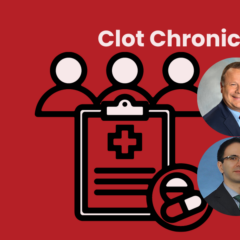Last updated on
What’s Hot in Clots – August 2024
Key Updates in Thrombosis
Table of Contents
To be aligned with the ongoing Olympics game, here are my three picks for this month:
Third place: Anti-seizure medications and DOACs: Cause of continued concern or false alarm?
For a while, pharmacists and clinicians have been concerned about enzyme-inducing anti-seizure medications being co-administered with direct oral anticoagulants (DOACs). The thinking has been that these medications may lead to lower DOAC levels and reduced effectiveness. A recent cohort study challenges this idea. I find this thought-provoking but will remain cautious until such results are verified by additional studies. Read more.
Second place: There is nowhere like home to treat pulmonary embolism
It is unquestionable that treating diseases from the comfort of one’s home is less costly and less disruptive to most patients. The only question is whether such a practice is safe. For PE, several individual studies had assessed the safety of early discharge or home treatment among patients deemed as low risk with the simplified Pulmonary Embolism Severity Index (sPESI) or Hestia criteria. However, those studies were small, leaving uncertainty about the safety of such practice. Now, in an individual participant, data-pooled analysis inclusive of more than 2600 patients, the authors show that early discharge is very safe, with a 30-day adverse event rate of 1.2%. In the accompanying Editorial, yours truly shares additional thoughts about this paper that provides the current best evidence on the topic. Read more and the Editorial.
And the gold medal (of the month): Telemonitoring for patients with acute coronary syndromes
Telemonitoring programs seem promising and have been pursued with lots of enthusiasm over the past two decades. Findings from some programs for conditions such as heart failure, however, have been less than ideal. Now in this single-institution, randomized trial from the United Kingdom, the authors demonstrate the benefits of telemonitoring after discharge from hospitalization with an acute coronary syndrome (ACS). If there are no issues with costs and widespread availability, I think this can be a very helpful addition for our patients with ACS. Read more.
For more updates, be sure to subscribe to get the latest updates each month.
Find this information helpful? Please consider making a small donation in support of thrombosis education & resources.

Behnood Bikdeli, MD, MS
Cardiologist, Section of Vascular Medicine, Division of Cardiovascular Medicine, Brigham and Women’s Hospital
Investigator, Thrombosis Research Group, Division of Cardiovascular Medicine, Brigham and Women’s Hospital
Assistant Professor of Medicine, Harvard Medical School
Investigator, Yale/ YNHH Center for Outcomes Research and Evaluation, Yale School of Medicine
Investigator, Cardiovascular Research Foundation



